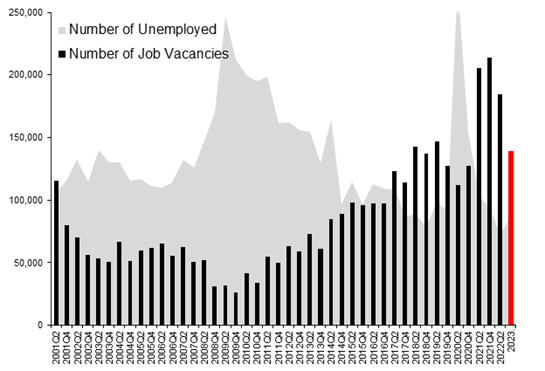6/7/2024 10:44:48 AM
St. Paul, MN – Job vacancies in Minnesota have declined by nearly one-quarter over last year, with employers reporting a total of 139,059 open positions in 2023, according to annual Job Vacancy Survey (JVS) results released today by the Minnesota Department of Employment and Economic Development (DEED).
Overall, job vacancies have declined by 24.7%, driven by a return to more normal hiring levels after rapid employment growth coming out of the Pandemic Recession and more people joining the labor force. This is the fifth highest number of vacancies on record in Minnesota dating back to 2002, but significantly lower than the numbers of vacancies reported during the previous two years.
Minnesota's labor market remains tight, with nearly two job openings for each unemployed person in the state. Compared to 2022, the number of vacancies decreased and the number of unemployed individuals increased slightly. With 87,000 unemployed workers statewide in 2023, there were 0.6 unemployed persons for each vacancy, up slightly over the last two years and just below levels prior to the Pandemic Recession.
"The Walz-Flanagan Administration is making historic investments that both increase equity in our economy and create work-ready employees to meet the needs of employers in high-demand sectors," said DEED Commissioner Matt Varilek. "Brand-new initiatives at DEED like Drive for Five, Targeted Populations Workforce Programs and Clean Economy Equitable Workforce are focused, high-impact strategies to help more Minnesotans enter the workforce and meet the meet the demand of our state's employers."

Statewide, the Health Care & Social Assistance industry had the most job vacancies with more than 36,000 openings (down from a record of 45,000 in 2022), followed by Retail Trade with almost 24,000 vacancies (compared to 28,500 in 2022), Accommodation & Food Services with 18,600 vacancies (compared to 26,000 in 2022) and Manufacturing with almost 11,800 vacancies (down from 19,000 in 2022). Combined, those four industries accounted for almost two-thirds of the total openings in the state.
The five occupations with the most job vacancies during 2023 were Retail Salespersons with 7,599 vacancies, Personal Care Aides with 5,669 vacancies, Fast Food & Counter Workers with 5,648 vacancies, Registered Nurses with 4,382 vacancies, and First-Line Supervisors of Food Prep and Serving Workers with 4,156 vacancies.
Regionally, 56.3% of all job vacancies were located in the seven-county Twin Cities metro area. Compared to one year ago, the number of job vacancies decreased by 20.3% in the Twin Cities and 29.6% in Greater Minnesota.
About the Job Vacancy Survey:
Employers provide information on their job vacancies to DEED's Labor Market Information (LMI) Office so that LMI analysts can estimate hiring demand and job vacancy characteristics by industry, occupation and firm size in Minnesota and compile information about wage, hours, educational requirements and other characteristics of vacancies. These 2023 findings are based on results from a survey of 6,996 firms, 20 industry sectors and four firm size classes. The 2023 survey had a response rate of 92.4%.
These data provide job seekers and counselors with information on occupations showing hiring demand within their region. The information also helps employment, training and education providers understand current labor market conditions in their region and tailor services to better meet customer and employer needs. JVS results provide more detail into Minnesota-specific job vacancy data than does the monthly Job Openings and Labor Turnover Survey (JOLTS) from the U.S. Bureau of Labor Statistics. For more information on how JVS differs from JOLTS please read this Minnesota Economic Trends article from DEED's LMI Office.
For more detail on vacancy numbers and rates by industry and occupation, as well as regional analysis, educational and experience requirements, wage offer trends and historical information, visit the Job Vacancy Survey page on the DEED website.
Visit the DEED website to view state and national employment statistics, monthly jobs numbers and data. You can also find alternative measures of unemployment. In addition, find related articles about job growth and labor market changes in the latest issue of Minnesota Employment Trends. Access resources to help Minnesotans prepare for and find employment now at CareerForceMN.com.
workforce
jobs